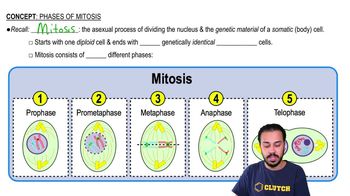Here are the essential concepts you must grasp in order to answer the question correctly.
Mitosis Phases
Mitosis is a process of cell division that consists of several distinct phases: prophase, metaphase, anaphase, and telophase. Each phase has specific events that lead to the separation of duplicated chromosomes into two daughter cells. Understanding these phases is crucial for identifying their characteristics and functions during cell division.
Recommended video:
Prophase
Prophase is the first stage of mitosis, where chromatin condenses into visible chromosomes, and the nuclear envelope begins to break down. The mitotic spindle starts to form, and spindle fibers attach to the centromeres of the chromosomes. This phase sets the stage for the alignment and separation of chromosomes in subsequent phases.
Recommended video:
Telophase
Telophase is the final stage of mitosis, characterized by the reformation of the nuclear envelope around each set of separated chromosomes, which begin to de-condense back into chromatin. This phase essentially reverses the changes that occurred during prophase, restoring the nucleus's structure and preparing the cell for cytokinesis, the final division of the cytoplasm.
Recommended video:






